'Useful' Castle Sets
Posted by Huw,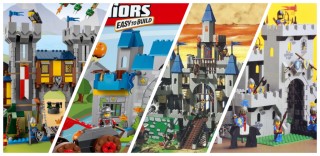
Just before things get hectic in December there's just time to publish this interesting article written by Davee123:
As soon as it was released, I bought a copy of 31120 Medieval Castle, and was immediately curious about something. Being a Creator set, was this possibly the least "juniorised" castle that LEGO's ever released? Almost everything in the set is a very useful, non-specialised piece.
By contrast, I recalled a nearly opposite feeling upon buying 6091 King Leo's Castle back in 2000. Dumping out the box, there were tons of pre-fab wall and battlement pieces, a big raised baseplate, and not many elements useful for general building. It felt similar to opening a Jack Stone or 4+ Juniors set.
The question I had now was: is there some way to measure that difference? Could we somehow come up with a metric for this?
If we're going to come up with a metric, however, we should figure out what we're talking about first. What is juniorisation? It's generally a way that LEGO tries to make sets that are easier to build for younger kids or those who aren't as interested in building. It often makes the sets less frustrating for these kids to build with, and gives them an end result sooner.
That can come in a variety of forms. We can easily look at a "helicopter body" element and conclude that the piece itself has been "juniorised". It's something that more-or-less could be built from other pieces, but is ready-made out of the box. These types of elements are strewn about, mostly in Juniors sets these days, where it's clear that this is LEGO's intent.
But they've also done something similar with other pieces which are less clear. There are 1x2 bricks with technic pins built in. Are these really juniorised? How about 1x6x5 bricks that could easily be made from five 1x6 bricks stacked on top of each other?
Many of these pieces, sometimes even while appearing juniorised, have functionality that couldn't be replicated with regular bricks. For instance, a 1x2x2 brick has an axle hole in the bottom that can be attached to an axle. Large BURP pieces often make use of the cavity within them for small "rooms" for minifigs to use. And many elements offer structural integrity you couldn't get from being made out of smaller pieces.
It seems like to "truly" decide when a set is juniorised, we need to know how each piece is being used, not just what parts it could be made out of. In some contexts, they might be used to make building simpler, and in others they may offer some functional or aesthetic purpose. And rating that would be exceedingly difficult. But could we come up with a rough guess, based on the individual pieces? I figured it'd be worth a shot. Maybe it would work, maybe it wouldn't.
For a first pass at this, I started off trying to gauge each LEGO element according to a simple "POOP" test (Piece-Of-Other-Pieces). Every piece in a castle set was given a "Junior" score based on how many other smaller elements it would "reasonably" be made out of. I tried to be consistent, but it was tricky. After all, you could construct a 1x2x5 brick out of 5 1x2 bricks, but you could also make it out of 2 1x1x5 bricks, or 15 1x2 plates, or even (Gasp!) 30 1x1 plates.
In an effort to be a bit less subjective, I also asked other AFOLs to rate various parts according to the same scoring guidelines, based on inventories of many castle sets from Rebrickable. I averaged these AFOL submissions together (about 15 total) with my own scores to get a rough idea of approximately how "juniorised" each piece was.
You can see here some of the highest scoring elements as rated by myself and these volunteers. Most aren't terribly surprising-- things like raised baseplates and BURPs scored higher on this system, as well as a smattering of other prefab building components like doors, walls, and staircases.
Finally, I then scored each set based on these numbers to get a "percentage juniorised" score:
(Actual Number of Pieces / Total Scores of all Pieces) * 100
How did it work? ... Okay.
It gave results that seemed more-or-less expected. 6091 King Leo's Castle was indeed one of the lowest scoring castles ("most juniorised"), and 31120 Medieval Castle was among the highest rated ("least juniorised"). So, in that regard, it was successful! But there were some interesting discrepancies compared to what my "gut" told me.
First off, this methodology did a huge number on sets with raised baseplates. And while I was silently hoping for this with sets like King Leo's Castle, I was also worried what it might do to sets like 6086 Black Knight's Castle-- a set that I really enjoyed, despite being on a raised baseplate. It certainly makes sense given the scoring method, but it also made me a bit disappointed.
But something else bugged me as well. I really loved the Crusaders and Black Falcon castles from my childhood. Sets like 6080 King's Castle and 6074 Black Falcon's Fortress I remember being awesome, but because they relied so heavily on castle wall panels (which got pretty poor scores), they were pushed much further down the list. Does this mean I was blinded by my nostalgia? Or is this metric lacking?
Lastly, I didn't really like the subjectivity involved. If I wanted to, I could easily give the old-timey castle wall panels a better score in order to force my favourite sets up to the top of the list. I'd really like to find a more objective strategy if possible.
So, time to try another approach.
I was reminded of a discussion I had had several years ago in the Brickset forum, where an excellent idea was suggested. We could try and gauge how "useful" a part is, rather than how "juniorised" it is. And we might be able to do that based on how often a part has been used in LEGO sets. The idea being that LEGO has already (to some extent) done the work for us by using "useful" pieces more often in their sets. In this way, maybe we could score sets by giving a bonus to each "useful" piece, instead of a penalty for those deemed "juniorised" subjectively.
This was a bit difficult. We could simply count the number of times a particular element was used in LEGO sets. But if a really "useful" piece was just released in 2021, would it be penalized simply because it's only been out for 1 year, whereas other similarly useful pieces had been around for decades? I tried to compensate for this by ranking every element's usage on a year-by-year basis, and then averaging all the years that the element was in production.
Rebrickable also made it a bit easier to ensure that I counted the use of the "base part". In the event of a printed element, or a different mould variant, Rebrickable sometimes helps by denoting "relationships" between parts, that can help to identify when an element is essentially the same as another one. This was especially necessary with things like minifig torsos, where many torsos are used in a year (IE, a more useful part), even though individual printings aren't always common.
The results of that element scoring were pretty unsurprising, but neat to see, nonetheless. Basic parts like the 1x2 brick or 1x4 plate were of course rated some of the most "useful" pieces. But there were a few surprises like the curved slope pieces, grill tiles, and double-width cheese slopes.
I rated each part from 0-1 (0 being not terribly useful, 1 being very useful). And to keep the overall mechanism the same in my calculations, I tallied sets' scores for each piece using (1 - Useful Score), allowing sets to get scores higher than "100%" for all the "Useful" pieces they had.
What did it do to the castles' ratings?
Much to my relief, it still gave 6091 King Leo's Castle a low rating (although not as low as I expected), and 31120 Medieval Castle a high rating (although not quite as high as I expected). But it did something else that I didn't expect. The classic LEGOLAND castles of the 1980s suddenly rated much higher! With their bevy of small bricks and plates, they ended up rating as extremely useful sets.
One of the oddities (which I suppose is to be expected with this method) was 10676 Knights' Castle. This set is actually a Juniors castle set, and has some giant pre-fab elements, so I'd like to see it score lower-- but it also has a ton of really "useful" pieces: bricks of various sizes (many of which are in bright colours).
Hence, I decided to try a compromise. I adjusted the weighting of the "usefulness" score so that the spread and standard deviations between sets were nearly the same as the "juniorised" score, and then combined the two into a single "combo" rating.
By this metric, was the new Medieval Castle the "least juniorised/most useful" LEGO castle of all time? Well, no. As you might have guessed, the clear winner is the classic 375 Castle! With almost nothing "juniorised" about it and tons of common pieces, it was way out in front. Its only detractors from having a perfect "Junior" score were its large baseplate, flags-on-poles, and drawbridge winch, each of which had at least one person rate with a score of more than 1.
In second place for large castles is the 10223 Kingdoms Joust from 2012. Even though I hadn't initially thought about this set, I'm pretty glad to see how well it ranked. It was designed more for the AFOLs out there than for the kids (as obviated from its 12+ age range) and I definitely remember feeling satisfied building its walls piece-by-piece rather than using panel elements. Although it didn't give us a fully enclosed castle, this was still a really good buy for a castle fan.
And in third place comes the Creator 31120 Medieval Castle! Impressively versatile for a castle set, with highly useful parts. And (as is frequently the case with Creator sets) almost nothing seems juniorised about the build. Despite being rather lacking in minifigs, it's definitely one of the better sets for castle building.
If you'd like to see the full results, you can view them in Google Sheets. I tried to rate every minifig-based set in the Castle theme, regardless of whether or not there was a castle included, as well as a few other sets that were tagged by Brickset as "Castle". You can get an idea for just what sort of scores these sets received.
So what's your opinion? Do any of these ratings look useful? What would you do to improve them?
233 likes
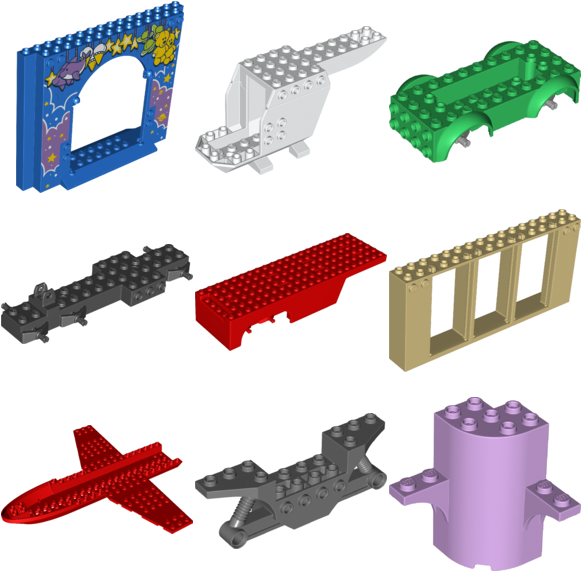
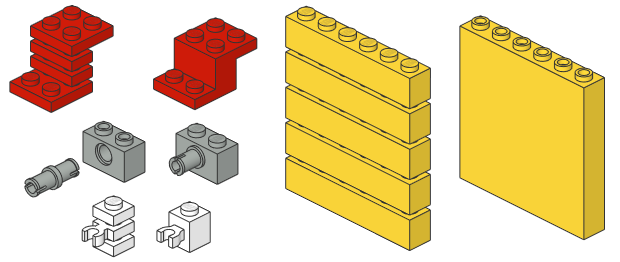

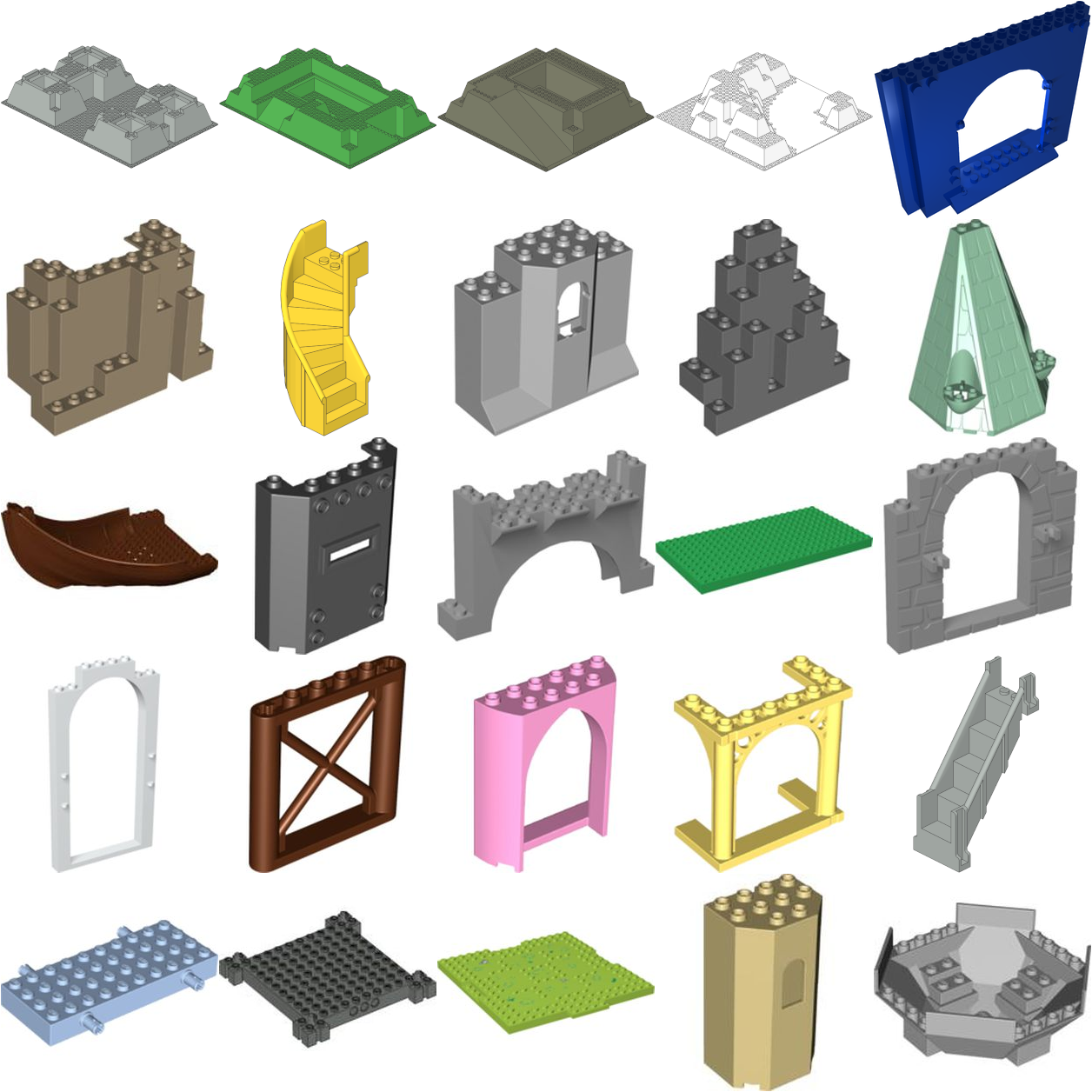
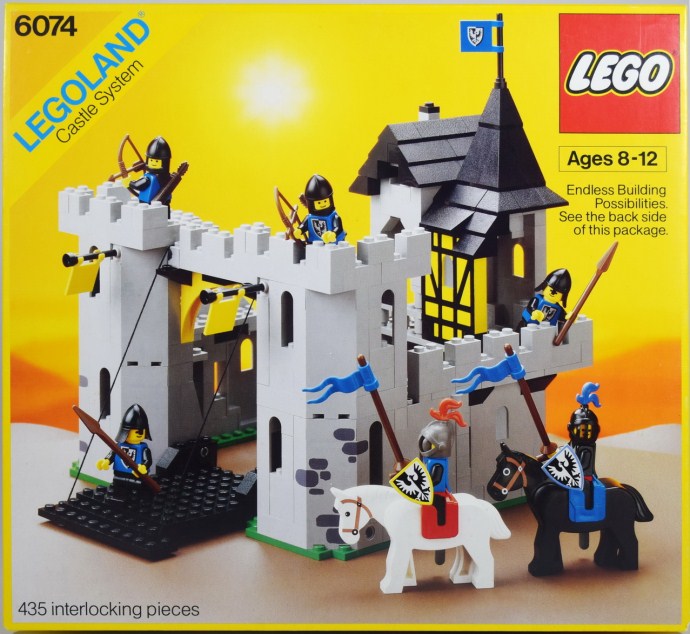
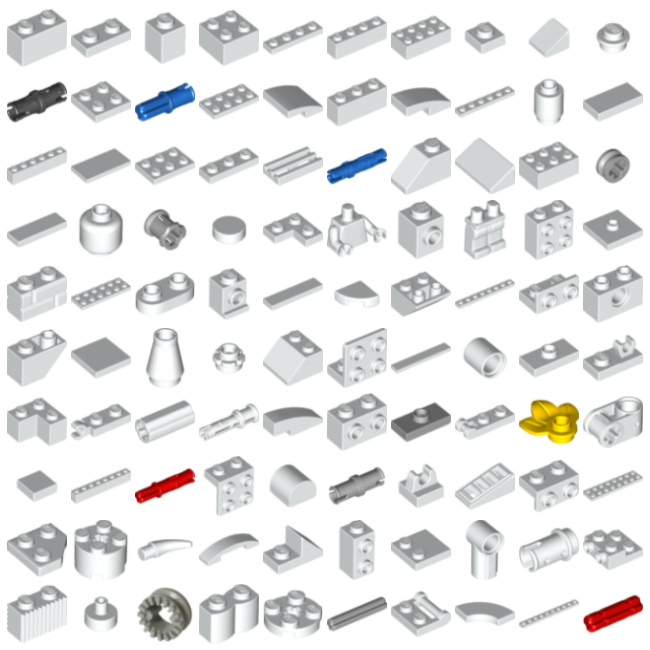
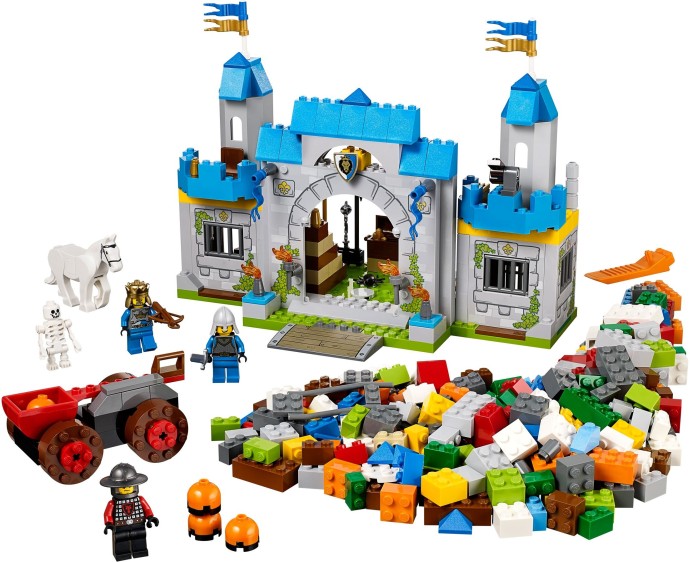
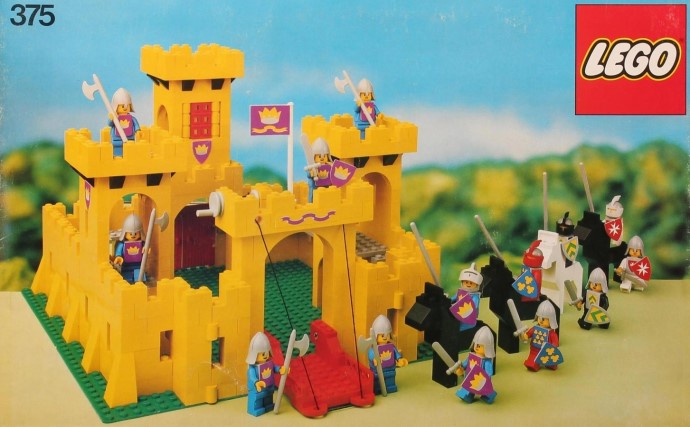
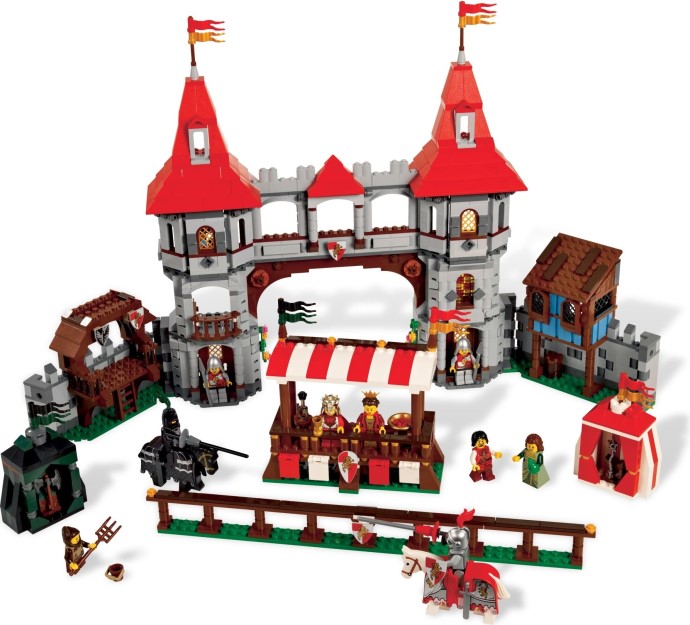
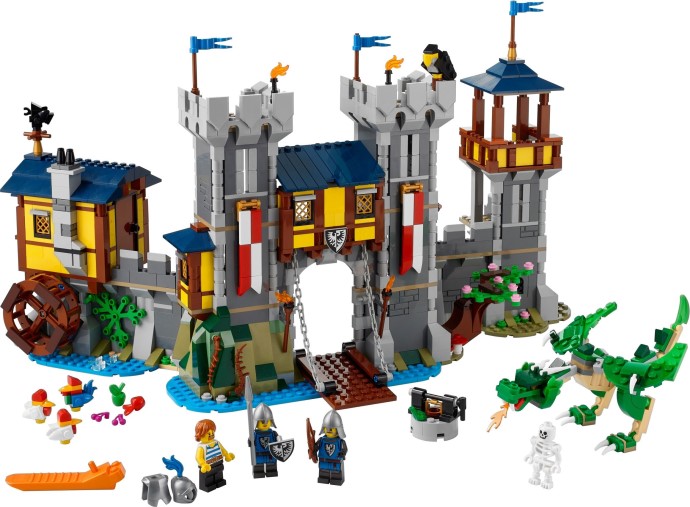
61 comments on this article
Fantastic article, I love that you included the various steps of your process and the logic behind them. Overall, a really brilliant way of applying scientific and statistic reasoning to something that feels really subjective and opinion-based.
I think the size of the piece plays a big part into how "juniorized" it is.
Good article. I like the analysis on part usefulness. There were a number of sets across a lot of themes in the early 2000's that were way too juniorized. I remember as a kid being frustrated with Lego for making so many bulky pieces.
I had a feeling that 10233 would have a high usefulness since when I first built it, I was amazed that Lego had created a castle set without any large wall pieces.
I’m not really into Castle, but I really like the concept behind this article! You had a question you wanted answered, and you came up with a couple of different metrics that might not be immediately obvious or required work, but were possible.
I like how the article tells the story of the process to explain why the metrics were chosen.
The only thing I would’ve changed/added is included some examples of pieces’ scores for each metric, maybe with a sentence of commentary (rather than just pictures of high scoring pieces), and if you were feeling generous, linked the data for the pieces too. That way other people could get a rough sense of the piece data, (and if they wanted to, do their own analysis).
For how in-depth the article got about the process of the two scores, I was surprised there weren’t examples of pieces scored.
Edit: I think an ideal example would’ve been the 1x2x5, since you start with it. You could use it to talk about how ratings between yourself and the other AFOLs differed, and for your “usefulness”, you could discuss how it’s commonly used, but not as much as (say) 1x2 bricks, and how that affects their scores on the 0-1 Utility scale.
Amusing and interesting research that tells us as much about our instinct vs preconceptions in relation to examined truths.
I love raised baseplates, pre-fab turrets, wall panels and... Pre-Fabuland!!!
Absolutely fascinating article. Thanks! I've been pondering the question of juniorization from a non-quantitative perspective for years now in reviews, so it's interesting to see someone else's thoughts. I like that you've constructed the model to capture AFOL intuitions but that it still has the capacity to surprise. I'd enjoy seeing this applied to the entire product range year-by-year, or by line within a given year.
Amazing article, I love ones like these. We’ve all had experience with sets we feel are juniorized, but what a great article to really try and quantify and narrow it down.
Very cool stuff. I missed out on 10223 but it looks like a great set.
I don’t have a problem with castle wall pieces, but I do appreciate the effort to find a “useful” scale. Nice article!
Nice to see 9474 Helm's Deep listed right at the top. I always thought it was such a well-made and surprisingly advanced build. I guess it got held back by the wall pieces used for the inner keep.
I love this website :)
Really interesting article. Wonder what the results would be if you applied this to Pirates sets. I love how the Creator Pirate Ship has brick built hull and sails rather than just relying on a couple of prefab hull pieces and a couple of cloth sails.
As a child I was always excited by big pieces- wall sections that could be easily piled on top of each other to make something imposing without overthinking the structural integrity. Being able to throw up the vague shape of the castle first then going in later to put in details was the best way to motivate me to build large-scale. I could achieve a more consistent colour scheme that way as well, not having access to a big bulk of grey bricks.
Helm's Deep was a game-changer, being such a massive parts pack of huge grey slabs that I could put together any shape of castle I wanted to- but also included sand green and dark bley parts to break up the potential monotony.
Today I'm still a big fan of huge pieces- the less 'useful' the part is, the more interesting the challenge of integrating it is! But of course, none of that can be done without the little pieces too!
I know A lot of people won't agree with me but I really like 10676. I bought it on clearance for my little brother and It was an immediate hit between me and him. It comes In a big red storage box which was good for him back then because we were running out of bins to store his parts. The Parts were super amazing. It came with 20 dark azure slopes which we both use a lot. It also came with a ton of basic parts that he didn't have much of and a ton of unique parts. The minifigures were a great addition to our collection. The build Isn't the best, but it did use some small parts mixed in with some big parts. We still have that tub and now my little brother (almost a TFOL) feels nostalgic about that set.
This is really a great piece on the impossibility of separating subjectivity from many if not most data-driven analyses. In moral philosophy the process described here is known as "reflective equilibrium" -- testing the outcome of a framework against our gut intuitions as a gauge of whether that framework is potentially valid.
"Part utility" should be considered as a serious metric, using both Lego's first-party builds for one score, and MOCs for another (if only a comprehensive database of MOCs existed).
Ultimately, though, "part utility" isn't entirely getting at "junior-ization," the latter being, of course, an entirely subjective assessment. Further, if the same themes keep coming back in Junior sets - helicoptor and motorcycle frames come to mind -- they would be objectively "useful" under this rubric but no less "junior" by the premises laid out in the article. Meanwhile, one-off parts that get lauded on Flickr for NPU would be considered "Junior."
Finally: why the hate on raised baseplates? What does building up a boring, plastic-heavy hill demonstrate as far as "Junior" is concerned? I've noticed among AFOLs a love for what I call "Lego as 3D printing," which is fine as it goes, but arguably a test of patience rather than creativity -- which (I noticed from comments on a different post today) some say is what Lego is all about.
That's part of why the 2021 Harry Potter series irks me so much. It seems like a major juniorization from the 2018-2020 series of sets they made. . While I had more fun that i expected (expected almost none), it wasn't the supreme joy of the 2018-2020 ones. I'd expect even the 2018 one to meet just the middle for some sets, the new ones, especially the Fluffy Encounter one is super juniorized.
I agree with others - this article is the reason why this site is FANTASTIC.
@ComfySofa said:
"I love this website :)"
I was thinking the exact same thing. Congratulations on an epic article!
This is really cool to see! Thank you for putting in the time and effort!!
This is a great article.
I have Medieval Castle and Kingdom's Joust still to build. Helm's Deep is one of my favourites as a castle, rather than because I have any interest in LOTR.
Can you do this with the train engines to find the most "Really Useful Engine"?
I own two castles: 6086 and the Bluebrixx Burg Blaustein with its expansions. The whole reason why 6086 stands up to today's Castle sets is how great the minifigs, accessories, and special pieces are like the portcullis 6046 and flag 2525pr0007.
I love that even the horses in 375 are not juniorized.
Please, add a link column to the spreadsheet:
=HYPERLINK(CONCATENATE("https://brickset.com/sets/",D2),D2)
Would be awesome if it's done to all sets, not only castles.
@Davee123 , Thank you for this most interesting and entertaining article!
Three concerns if I may:
1. The usefulness metric is subject to distortions due to the economies of part production. LEGO’s designers have to justify new parts by using them a certain number of times. The exact number of times (or number of sets they appear in) varies due to a multitude of factors (design costs, production capacity, colours, time, licensing etc). But each will artificially impact the usefulness score.
2. The number of different parts has increased over the years. So earlier sets are more likely to have contained ‘useful’ parts than more recent sets. A method is needed to control for that.
3. Juniorisation is not just about part (mould) usage. It also includes aesthetic considerations such as the colour choices, and functionality/design considerations such as having buildings that are open at the back for play or are defensively/structurally implausible such as the exposed format of 70403 Dragon Mountain.
I had to go look up what a BURP was (Not disappointingly turns out to be Big Ugly Rock Piece!!). Great article though, amazing level of well thought out methodology to a very interesting subject. Well done.
The definition of 'useful' used here is an interesting pick, which comes out at which parts are shared across the largest number of sets, then counting which set has the highest number of those parts.
However I do feel the other metric you mentioned in the beginning should be considered as well, when measuring the usefulness of a set , because useful can also be interpreted as 'how can I save cost or time building', or 'what can this part do that many small ones cannot'.
On that point LEGO is really getting the balance right of small and larger parts these days, at least in my opinion. The new 31120 Medieval Castle is a great mix, and shows years of evolving sets!
Thanks for the very interesting read!
Great article!
It's a pet pieve of mine that people often throw around the term 'Juniorization' for sets that aren't even close to what it was like in the late 90s/early 2000s. So it's nice to see a deeper dive into what it is, and especially to see the limits of the term:
It's subjective, but is related to a very real trend in some themes and subthemes at various points in time. The 4+ theme clearly is juniorized. Town Junior was juniorized. But using wall panels or specialized pieces doesn't make something any less juniorized than castles were in the 80s. The Star Wars sets like those with incoherent colour schemes from 2001 like 7127 aren't juniorized, just colour blocked to make the build more kid-friendly.
I've built 375-2, and there's a reason we don't still build our horses from plates, bricks and slopes and our walls with exclusively 1xX parts anymore. The build is fun, but a lot of work for a kid, there's no texture, there's a lot of weight and there is some fragility in thinner places. Not to mention the price it originally demanded was steep if you account for inflation.
Sets come in all shapes and sizes now, and it's only when these specialized parts are abused or used to simplify unnecessarily when it can be called juniorization on non-lower age range sets.
I'm glad there's now a more objective way to use the term :)
@LegoAthos said:
"I think the size of the piece plays a big part into how "juniorized" it is."
The largest LEGO part currently in production is the 48x48 baseplate, which is extremely useful and versatile
The Burps are great for mountainsides. After 99, too juniorized. Today-2021, nope.
Wow, this article is (the good kind of) crazy :-)
I presume Löwenstein Castle would be a top contestant. Was it too 'obscure' to be included?
Thanks everyone!
@N_Cat said:
"The only thing I would’ve changed/added is included some examples of pieces’ scores for each metric, maybe with a sentence of commentary (rather than just pictures of high scoring pieces), and if you were feeling generous, linked the data for the pieces too. That way other people could get a rough sense of the piece data, (and if they wanted to, do their own analysis)."
I can certainly provide some links to the part scoring-- the resulting numbers once averaged together looked a bit odd, and I did some finagling with some of them that I kind of thought might put people to sleep while reading (not to mention being a bit unfamiliar in terms of how "base" parts were derived).
Ideally, I'd love to let people play around themselves with the data, although it proved to be some intensive manual labor and took number-crunching time to process. So for now, I figure it's a conversation starter, but I'd love to work towards getting a tool together that could let people generate these kinds of metrics on their own.
@Padmewan said:
"Ultimately, though, "part utility" isn't entirely getting at "junior-ization," the latter being, of course, an entirely subjective assessment."
The term "juniorization" probably isn't the best moniker for what I was trying to dial in to, and neither is "useful". I'd love to hear people's thoughts on it, though, since I sometimes find myself wanting to use this concept in discussions, and I don't really know if there's a great word for it, or if it really needs to be broken down further.
@Elcascador said:
"I presume Löwenstein Castle would be a top contestant. Was it too 'obscure' to be included?"
I waffled on including it since it was part of the BrickLink designer program, rather than a standard release-- but I don't think Rebrickable had an inventory for it, so that made the decision easier!
The other thing I'll mention is that I played with a few other ideas that I didn't add to the article, such as BrickLink pricing/sales for elements, desirability of colors, and a few other subjective metrics that I found difficult to be consistent on. There's a lot of depth for this topic that certainly could be explored!
Is there any chance you could add in sets that include castles occupied by mini-dolls? Some of the Disney princess castles have had a number of iterations - and though it is pretty obvious which ones are going to have more "useful" parts, it would be interesting to see where they rate in comparison.
As examples:
41055-1 Cinderella's romantic castle
41180 Ragana's magic shadow castle
71040-1 Disney castle
One thing the Elves and Disney themes do well besides color is include a lot of details. That doesn't make them useful, as I predict all those hairbrushes and lipsticks will demonstrate.
I do like the term 'useful' rather than 'juniorized' here because when we consider the mini-doll castles, there is an implication 'juniorization' is equivalent to 'feminization'.
As others have pointed out, panels have their uses, and one of the big ones is to get something you can play with, fast.
So another way to look at might be a spectrum of "builder-centric" to "player-centric" (or something), which better reflects what the sets are good *for*.
Ironically, 31120 is one of the LEAST useful castle sets due to the lack of horses, wall panels, minifigures, etc. It actually offers very little special bricks. The pirate ship had a similar issue with lacking sails and a hull. They are common and could be bought cheap on Bricklink. While other castle sets skyrocket in value, LEGO gives us one made of low-value pieces. This is why these Creator sets have a cheap PPP. Of course it still is a great set. But these classic theme related Creator sets just don't feel right. Everything is made of small pieces, no special molds allowed. In an alternative model, there is a brickbuilt mouse. https://brickset.com/sets/theme-Service-Packs?query=castle Many fellow users have suggested LEGO make an Xtra pack like these to rectify the situation. How many "Castle Accesories" from the service packs are in the Creator castle? 3 flags, 2 feathers, 2 shields, 5 flagpoles, 1 bow, 1 spear, 1 sword, 3 helmets, 1 breastplate, 1 fire, 1 target. Compare that to the comparably priced Castle theme castle from 2013, which at the time was considered to have an embarrassingly low minifigure count, much like 31120. 70404 had 6 helmets, 1 lance, 4 flags, 2 breastplates, 2 feathers, 1 spear, 1 axe, 1 crown, 5 shields, 1 quiver, 2 crossbows, 1 bow, 3 swords, 9 fires. And that's going by LEGO's own service packs criteria of castle parts. There is a discrepancy between them, from the little pieces upward to horses, wall pieces, plastic printed banners, portcullis, etc.
Even as a child I disliked large pieces, I didn't want to finish the build ASAP, I wanted it to last as long as possible!
This year I collected all of the Hogwarts sets, but I was disappointed by the simplified look that the large wall pieces gave them, almost like they were made from old-style wooden blocks. This unrealistic look was worsened by the modular concept. I wish TLG would produce more adult-themed, modular Hogwarts sets.
Well, that was gratifying. I have six of the top twelve, as seen in the Google Sheets davee123 provided. Whew! I haven't yet opened 10176 ("Royal King's Castle") but am not surprised that the two scores are so different (74.98 in the first scoring method and 138.62 in the second). I really like davee123's analytical approach to this, and appreciated the amount of effort and time that must have gone into it.
Also, I'm not surprised that an LOTR set and a LEGO Elves set scored so high (number 5 and number 6, respectively). I miss those two themes, but am happy I got almost all of the sets in each of those two themes.
Thank you, davee123!
@popLife said:
"Is there any chance you could add in sets that include castles occupied by mini-dolls?"
It's already there! The list is sorted according to the "Castle" column, which is basically showing "Does this set contain a structure in it?", and then by the Combo score. I had several categorizations for the castles themselves (which was also subjective):
* Full - Has a full-size castle (not necessarily enclosed)
* Small - Has a smaller-than-full size castle (very subjective)
* Mini - Has a really itty-bitty castle-like building (Black Monarch's Ghost, for instance)
* Other - Has a structure in it that ... isn't really a castle per-se
* N - No real structures (just vehicles, landscapes, and/or minifigs)
@CCC said:
"Let's invent one! The MOCability index. You could score each part by how many (castle) MOCs a part appears in, and how many times per MOC, then rank official sets by seeing how many high MOCability parts they include."
Oh, that sounds cool! Ideally, I would love to measure the "desirability" of pieces according to AFOLs. I thought about doing this with a few different metrics, like BrickLink sales, but MOCs on Rebricable could work too.
LEGO needs to re-release the joust set (10223)! It looks outstanding…
Another metric that might tell how juniorized an element is how much usable empty space would remain if the element was encased in one large brick. This metric wouldn’t penalize elements that are one piece rather than multiple pieces. For instance, there would be a lot of usable space left over if the helicopter body element was encased in a brick. But there would be no usable space leftover if a 1x2x5 brick was encased in a brick.
This article is why I love Brickset so much!
@davee123 said:
"The term "juniorization" probably isn't the best moniker for what I was trying to dial in to, and neither is "useful". I'd love to hear people's thoughts on it, though, since I sometimes find myself wanting to use this concept in discussions, and I don't really know if there's a great word for it, or if it really needs to be broken down further."
As US Justice Potter Stewart once wrote, "I shall not today attempt further to define the kinds of material I understand to be embraced within that shorthand description; and perhaps I could never succeed in intelligibly doing so. But I know it when I see it...”
Is it mere poetry or an actual relationship that Justice Potter was writing about "adult" materials, and we are discussing "junior" toys?
Recently a friend gave us an enormous microblock set. It comprises literally thousands of plastic bricks that you layer painstakingly. The instructions remind me of set 375, which I owned as a child, in that it didn't go one tiny incremental step at a time. It was miserable, no one had any interest in building it, and it sat there for months until I recently re-plated it like a leftover casserole, and suddenly my younger child decided to make their own design. The fact that they are nine (older than I was when I built 375) has nothing to do with "juniorization," I don't think. As a nine-year-old, I remember looking at my friend's gray Lego castle and thinking the big chunky pieces were "cheating." Even then I wondered if Lego was dumbing down its products. It was a precocious snootiness, but possibly also sour grapes and a presaging of my Dark Ages.
I think this is why now I am working on MOCs that redeem these unloved pieces, some, I suspect, unloved because they are considered for younger children or, worse, "for girls." I'm not sure if that was what @popLife is trying to say, but as a huge fan of Elves I would like to point out that, no, Ragana's castle was not filled with lipstick but rather very fun building techniques that managed to beat interesting architecture out of square blocks.
(Might I also add that play features INCREASE, not decrease, the complexity and sheer cleverness of a build. I'm sorry, but anyone can spray bricks into a massive sculpted shape, but it takes ingenuity and knowledge of Lego interconnections and geometry to make these features work).
31120 is not really a castle set. It’s not a set with castle accessories. The last useful Castle set was back in 2013. Yes, it’s been almost 10 years. You could argue Blacksmith set is a castle set but it really isn’t
Interesting article, but I feel like you kept fiddling with the test until you got the results you wanted...which probably isn't the most fair way to come up with a test for Juniorization. Not to say 375 (6075) doesn't deserve the top spot, but if 31120 hadn't been in the top 3 I suspect you'd have kept tweaking things until you saw results you wanted. Not a very scientific method.
Thank you for sharing your fun experience!
A potential “machine learning” approach could have been to use a tf-idf applied to parts instead of words and a prediction based on the age of the set. This way you can remove the subjective aspects of the juniorised ranking by AFOLs. ;)
For folks who want a different take on most "useful", or most used LEGO pieces, check out Tom Alphin's analysis at brickarchitect.com.
https://brickarchitect.com/most-common-lego-parts/
@PDelahanty said:
"Interesting article, but I feel like you kept fiddling with the test until you got the results you wanted...which probably isn't the most fair way to come up with a test for Juniorization. Not to say 375 (6075) doesn't deserve the top spot, but if 31120 hadn't been in the top 3 I suspect you'd have kept tweaking things until you saw results you wanted. Not a very scientific method."
Well, seeing as how 31120 came up in 3rd place in the initial "Junior" ranking system as well as the "Combo" method, I'll have to disagree!
The process was more nuanced than I went over in the article. 31120 was the inspiration to delve deeper, but I wasn't really trying to make it come out on top or anything. It's a cool set and all, and it made me think about it while scrutinizing it, but I'd be fine if it came out in 11th place or whatever. The reality is I chose 5 sets that I thought were pretty non-juniorized, and figured "these should be in the top somewhere":
3739-1 Blacksmith Shop
375-2 Castle
10223-1 Kingdoms Joust
21325-1 Medieval Blacksmith
31120-1 Medieval Castle
Then, I did the same thing for sets that I felt were a bit more heavy-handed with their Juniorization levels, and picked 5 sets that I thought probably should be towards the bottom of the list:
8813-1 Battle at the Pass
8781-1 Castle of Morcia
6076-1 Dark Dragon's Den
6091-1 King Leo's Castle
8823-1 Mistlands Tower
These were my litmus tests to see if my methodology was doing what it should. If 6076-1 came out near the top of the list, or 31120-1 came out near the bottom, then whatever I was doing wasn't working. I wouldn't be trying to measure "that thing" that I was trying to measure when I refer to "feeling a set is juniorized". But in practice, it didn't really end up happening, so it didn't much matter.
Anyway, my end goal was really to stimulate discussion around the topic and try to be as objective as possible. I'd love to have another go at it if there's a different way of measuring things that's feasible.
Honestly I LOVED the raised baseplates (and BURPs) as a kid and now. I miss a lot the raised baseplates.
I think there's ways t use them in a clever way. Plus I love the challenge of building around them.
My favorite Castle set ever "6086: Black Knight's Castle" still, in my opinion, the best and most balanced Castle set ever.
@morvit said:
"31120 is not really a castle set. It’s not a set with castle accessories. The last useful Castle set was back in 2013. Yes, it’s been almost 10 years. You could argue Blacksmith set is a castle set but it really isn’t "
You need to broaden your horizons mate :) Because you will sleep on many amazing castle pieces.
I LOVE HP line as Castle partpacks for example.
Fantastic article. Just read the sheet, and was particularly surprised to see the Hogwarts Great Hall so low!
Long winded way to say you came up with a system to give a number to a predetermined outcome.
You wanted sets with many small pieces to rate as useful and sets with BURPs etc to rate as not useful. That’s what you then designed. Unsurprisingly the answer you wanted came out. A number gives it the gloss of objectivity but it’s not. A quick glance down the parts list on Bricklink is as useful as this metric.
@PDelahanty said:
"Interesting article, but I feel like you kept fiddling with the test until you got the results you wanted...which probably isn't the most fair way to come up with a test for Juniorization. Not to say 375 (6075) doesn't deserve the top spot, but if 31120 hadn't been in the top 3 I suspect you'd have kept tweaking things until you saw results you wanted. Not a very scientific method."
@jsworpin said:
"Long winded way to say you came up with a system to give a number to a predetermined outcome.
You wanted sets with many small pieces to rate as useful and sets with BURPs etc to rate as not useful. That’s what you then designed. Unsurprisingly the answer you wanted came out. A number gives it the gloss of objectivity but it’s not. A quick glance down the parts list on Bricklink is as useful as this metric."
In developing indices, it is often necessary to adjust them until they meet a subjective standard of realism. It's just the way such things are done.
The test though would be to see, once the methodology is finalised, whether it works for other lines or types of builds like superhero vehicles or City buildings.
@CCC said:
" @Elcascador said:
"Wow, this article is (the good kind of) crazy :-)
I presume Löwenstein Castle would be a top contestant. Was it too 'obscure' to be included? "
That has six BURPS/MURPS in it plus a rock panel."
Not too bad, considering it has 2.000 pieces.
The usefulness of a piece should also be related to how many different uses for the same piece, rather than the same 6x5 wall panel appearing in nearly ever Friends set as a wall panel. This would be difficult to automatically calculate from queries as subjective, but from your element scoring picture I can see pieces that have been used in dozens of ways whereas large junior pieces usually have only 1 use.
Similarly, prefab walls and rock formations in Harry Potter are very common, so on a HP parts inventory scale would score high on usefulness assuming all you wanted to do was build walls and rock formations, but have little other use.
@Norikins said:
"Ironically, 31120 is one of the LEAST useful castle sets due to the lack of horses, wall panels, minifigures, etc. It actually offers very little special bricks. The pirate ship had a similar issue with lacking sails and a hull. They are common and could be bought cheap on Bricklink. While other castle sets skyrocket in value, LEGO gives us one made of low-value pieces. This is why these Creator sets have a cheap PPP. Of course it still is a great set. But these classic theme related Creator sets just don't feel right. Everything is made of small pieces, no special molds allowed. In an alternative model, there is a brickbuilt mouse. https://brickset.com/sets/theme-Service-Packs?query=castle Many fellow users have suggested LEGO make an Xtra pack like these to rectify the situation. How many "Castle Accesories" from the service packs are in the Creator castle? 3 flags, 2 feathers, 2 shields, 5 flagpoles, 1 bow, 1 spear, 1 sword, 3 helmets, 1 breastplate, 1 fire, 1 target. Compare that to the comparably priced Castle theme castle from 2013, which at the time was considered to have an embarrassingly low minifigure count, much like 31120. 70404 had 6 helmets, 1 lance, 4 flags, 2 breastplates, 2 feathers, 1 spear, 1 axe, 1 crown, 5 shields, 1 quiver, 2 crossbows, 1 bow, 3 swords, 9 fires. And that's going by LEGO's own service packs criteria of castle parts. There is a discrepancy between them, from the little pieces upward to horses, wall pieces, plastic printed banners, portcullis, etc."
i always thought castle sets always had too few shields.
Very interesting and nice article, DAVEE123 !
Let's not say DAVEE fiddled with the methods until he got the results he wanted, but looked to see if there are more than one way to look at the data and how it fits into his hypothesis (that 6091 is crap on CRAPP and 31120 very useful). If he purely ignored all findings but the last, then he might be quite guilty.
I tend to agree with the logic and findings. Although everyone has their preferences and I thought 8813-1 Battle at the Pass was quite ok/good with the minifigures and small fortress, I would completely agree with everything else, even your strong grudge against 6091 !! this single set put me into my Lego dark ages (although I must admit, 6091 also made me realize my passion is modifying sets as opposed to making and leaving or pure MOCs).
While 31120 won't sit at the top of my favorite castles list, it is a very useful set for adding to castles or building your own! I used to be so disappointed in all creator/classic buckets since the colors rarely added to castles... this feels like the first classic bucket ever made for castle fans. At double the price of 10676 , it's much more than double the value for castle fans.
Perhaps you could continue with the same analysis, but also taking into account piece color (priority on greys and blacks)? this might not have much effect other than lowering 375-1 and 10676 but it might be yet another way to see the castle sets.
@jsworpin said:
"Long winded way to say you came up with a system to give a number to a predetermined outcome."
Exactly! I mean, sure, I can identify a set as being "juniorized" myself already. But the trick is trying to contrast things that are very different in theme, like 41078 Skyra's Mysterious Sky Castle compared to, say, 75826 King Pig's Castle. That is, can I come up with a systematic way of enumerating these sets' respective "juniorization" levels? Or am I permanently stuck having to do some hand-wavey manual process based on my own gut feeling for everything?
@jsworpin said:
"A number gives it the gloss of objectivity but it’s not. A quick glance down the parts list on Bricklink is as useful as this metric."
Well, the resulting number itself isn't actually intended to provide objectivity-- it's intended to provide nuance and consistency. If I wanted to compare two sets in terms of their juniorization, I might give you a different answer depending on whether or not I had recently built one of the sets, or how badly I was yearning for particular parts based on specific projects I was working on at the moment. But with this metric, I can do that without my own feelings at that moment messing with my judgement too much. The main subjective component (which I wish removed judgement) was evaluation of individual elements' Junior scores.
Furthermore, that number has the potential (I don't think it does in practice-- just in theory at the moment) to let me know when something interesting might be going on with a set. That is, if I think to myself "yeah, that set looks kinda useless", and then it scores really well... maybe I ought to give it more scrutiny? If we could perfect the system, maybe it could help do that, I'm not sure. In the end, it's not going to replace a scan of the inventory or anything. But it might help provide some color.
@BlackFalconBirdman said:
"Perhaps you could continue with the same analysis, but also taking into account piece color (priority on greys and blacks)?"
Funny you should suggest that, it's exactly what I did at one point!
While experimenting with the numbers, I tried a few things that really didn't have anything to do with "juniorization" per se, but had more to do with personal taste and value:
1) I gave a weighting factor to colors. I believe I gave colors a bonus score for being a muted color like gray, dark gray, dark tan, tan, etc. And meanwhile, I gave colors a lower score for being bright colors like red, pink, blue, magenta, etc. (Actually, I tried a few variants on that idea) It had similarly predictable results-- it pushed 375-2 way down the list, as well as 10676-1, and other sets rose to the top.
2) I tried multiplying the "Junior" score times the piece count, as well as comparing that number to retail cost (only for a few sets, since retail cost wasn't in the Rebrickable data). At the time, there were lots of minifig packs and such filling up the top of the list, which were scoring perfect 100% ratings, even though they didn't have any castles in them to speak of. So it pushed larger sets up to the top, giving a bit of a handicap to Juniorized sets.
It was neat to play around with! Ideally, I'd love to build some evaluation tools to let people fiddle with the data themselves. But it was kinda tricky to do that since it involved a lot of number-crunching and inventory data. It would be difficult to support that anywhere other than as a server-side calculation, and I don't have a system ready to go for anything like that. But I can still dream!
As you said, Juniorization is always a complicated topic when it comes to discussing LEGO builds. Just because a part is large doesn't necessarily mean it's useless. Often it's more of a gut feeling of "what can I do with this, how can I repurpose it."
One thing I've got to disagree on though is raised baseplates. I absolutely adore them and I think it's a shame LEGO doesn't do them anymore. Getting cliffs that massive can take an insane amount of bricks creating a heavy and expensive assembly with little build value, so getting the foundation out of the way step-1 is great and makes the model easier to move around.
Great article! Love that pic of the 100 'most useful' elements.
@DAVEE123
2) I tried multiplying the "Junior" score times the piece count, as well as comparing that number to retail cost (only for a few sets, since retail cost wasn't in the Rebrickable data).
Ahhh, interesting.. trying to take piece count in, though that would also put 10676 near the top, I'd suppose...
retail cost is also interesting, but the earlier castles would take quite a hit due to their relative cheapness. Or you could combine the two (= price per piece), which would put 31120 pretty high up there.
Personally, I'd like to see a price per ABS weight ratio? (since I like the CRAPP in 6091 , just not the crap that IS 6091 ), or a 'wall height and enclosed area vs price and piece'- ratio. A sort of 'how big of a deal of a castle are you getting.
There are lots of interesting ratios to look at, but like you said, it would be a great deal of data collecting work...
anyways, very nice article to be thinking about!
Articles like this are what set this site apart. Fantastic analysis.
I appreciate the amount of time and effort you put into this, but I feel like you've been busy finding a calculation method that will yield the ranking you want. Moreover, I would think that any respected AFOL can easily estimate the juniorisation level based on pictures and the parts inventory. So, personally, I don't really see the added value of this metric. But if other people do, then who am I to say you have too much free time?*? ;-)
* That's me being jealous...
A fun exercise for sure, but the resulting list still seems extremely flawed considering it puts 6067 Guarded Inn almost near the bottom, among many other examples.
I guess there really is no way to objectively determine juniorization other than designer intention, haha.
The nerd in me loves the nerd in you.